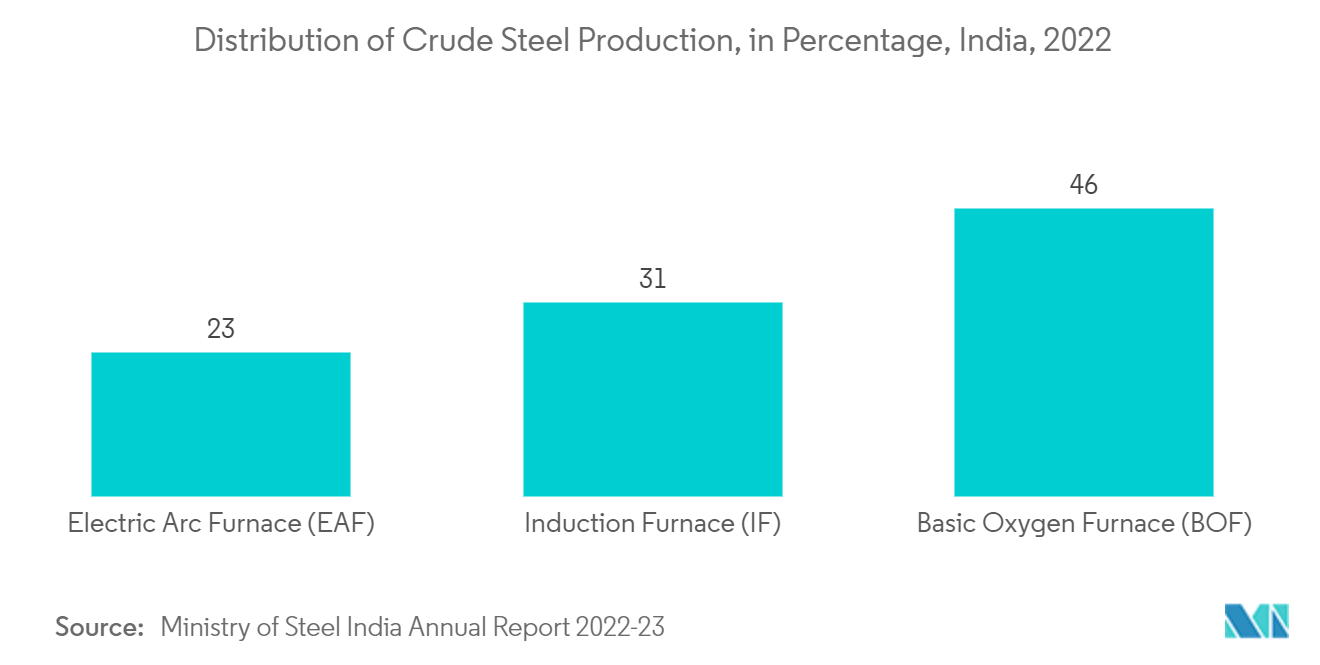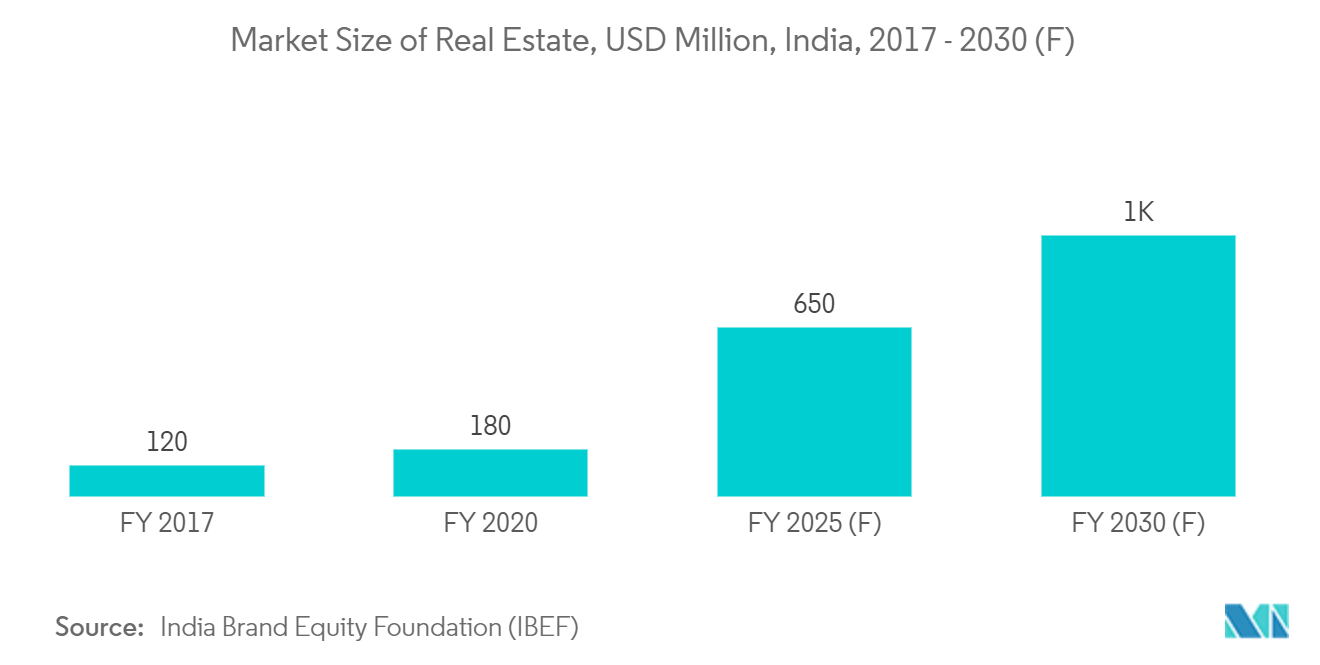Market Trends of India Steel Industry
Blast Furnace-Basic Oxygen Furnace (BF-BOF) Technology to Dominate the Market
- The BF-BOF route is a two-stage process: Ironmaking: Iron ore, coke, and limestone are charged into a blast furnace. The iron ore is smelted to produce molten pig iron. Second, it is Steelmaking: Molten pig iron is charged into a basic oxygen furnace (BOF). Coal is used as the primary carbon-bearing material for steelmaking. It generates high temperatures necessary to smelt the iron ore and convert it into liquid iron. This liquid iron enters the converter, where oxygen is blown through the molten iron to remove carbon and other impurities.
- The resulting steel is cast into ingots or slabs and processed into long products like bars, wire, or flat steel strips in several rolling operations. To enhance the characteristics and functions of steel, tempering or coating applications are also done when required.
- Blast furnaces can produce up to 10,000 tons of molten pig iron daily. Then, BOFs can produce up to 300 tons of steel per heat.
- A basic oxygen furnace (BOF) was the most preferred process route for the production of crude steel in India. It accounts for over 90% of the country's steel output. At the end of 2022, BOF technology accounted for 46% of the production.
- In India, 68% of steel is made through the Blast Furnace route in which coking coal is the primary reductant. At the same time, Pulverised Coal Injection (PCI) or Natural Gas can be used as an auxiliary reductant. Green Hydrogen to replace PCI in the BF-BOF route is under development.
- According to the Ministry of Steel of India, BOF was the most preferred process route to produce crude steel in India at the end of 2022, with around 57.43 million tons (46% of total crude steel) produced, which was 8.35% higher than in 2021.
- Most BOF plant installations will occur in India in the forecast period. For instance, Tata Steel BSL Ltd. plans to add 6.07 MMT of BOF capacity at the Meramandali works and 3.0 MMT of BOF capacity at the Kalinganagar works in Odisha state by FY 2024. Moreover, India holds an additional 50.0 MMT potential gross capacity.
- Therefore, considering the growth trends of blast furnace-basic oxygen furnace (BF-BOF) technology in India, the BF-BOF technology is likely to dominate the market. It, in turn, is expected to enhance the demand for steel during the forecast period.

Building and Construction Industry to Dominate the Market
- Steel is a man-made alloy that falls within the ferrous metal classification. It contains iron (a naturally occurring metal element on earth), carbon, and other components. Construction is a sector where steel is widely used since structures are created using it due to its high durability and strength. Steel structures can also withstand natural calamities and be tailored to the needs of a specific project.
- Products, such as roofing, purlins, internal walls, ceilings, cladding, and insulating panels for exterior walls, are made of steel. Steel is also found in many non-structural applications in buildings, such as heating and cooling equipment and interior ducting.
- Buildings from houses to car parks, schools, and skyscrapers all rely on steel for strength. Steel is also used on roofs and as cladding for exterior walls. Internal fixtures and fittings, such as rails, shelving, and stairs, are also made of steel. It provides a robust and stiff frame to the building.
- According to the National Investment Promotion and Facilitation Agency, the building and construction industry accounted for nearly 9% of the GDP in FY 2022-23. Nearly 51 million people are employed in the industry. Moreover, The industry is expected to reach USD 1.4 trillion by 2025 owing to rising residential and non-residential sectors in the country.
- According to the Confederation of Indian Industry (CII), housing construction in the country witnessed strong demand in 2022, with the top seven cities (Delhi NCR, Bangalore, Hyderabad, Mumbai, Pune, Chennai, and Kolkata). It added around 402 thousand units of new home construction, which was 44% higher than in 2021. In the first quarter (Q1) of 2023, housing sales in the top seven cities stood at 1.14 lakh units, an increase of over 99,500 units compared to 2022.
- Government social sector programs such as the Pradhan Mantri Awas Yojna, which promotes housing for all, the Sardar Patel Urban Housing Project, the 100 Smart Cities Mission, and the construction of infrastructure in medium and small towns are promoting the growth of the Indian steel industry.
- The Government of India strongly focuses on infrastructure development to boost economic growth. In 2022-23, the government allocated around INR 64,573 crore (USD 7,773.56 Million) for developing new roads and bridge infrastructure. The ministry issued INR 2,600 crore (USD 313 Million) to construct non-residential office buildings under the Central Vista Project. Moreover, under the National Infrastructure Pipeline (NIP), infrastructure projects worth INR 108 trillion (USD 1.3 trillion) are at different stages of implementation.
- Therefore, considering the growth trends of building and construction in India, the building and construction industry is likely to dominate the market. It, in turn, is expected to enhance the demand for steel during the forecast period.


